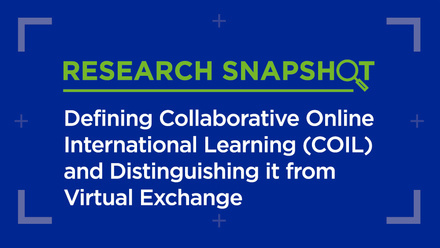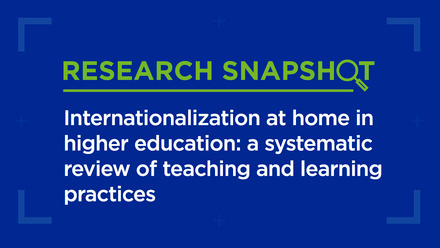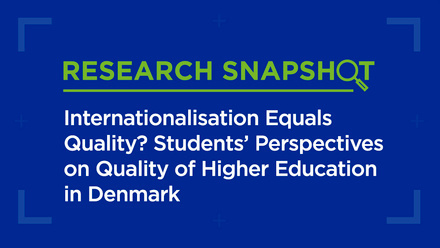Virtual exchange and Internationalisation at Home: the perfect pairing

In the midst of the pandemic with the ensuing lockdowns, online platforms and digital tools have become our 'first aid kit’ to keep international education going and maintain international exchange. Virtual mobility and virtual exchange have appeared as a quick fix in times of closed borders – but are we really engaging in international virtual activities for the right reasons? In this blog post, we suggest a different take on virtual exchange: instead of relying on student mobility for internationalisation activities, we need to shift our gaze to what all students need.
Among the Internationalisation at Home in practice, joint online activities hold the promise of transcending borders in a (seemingly) effortless fashion. Over the years, higher education institutions have thus engaged in various modes of cross-border online collaboration with the aim of internationalising their teaching and learning. With the sudden halt to physical mobility, a veritable surge in virtual activities can be observed.
These go by many different names, depending on the context from which they arise. Virtual mobility refers to students and academics in higher education using another institution outside their own country to study or teach for a limited time, without physically leaving their home. Although this allows for access to perspectives and knowledge not available on the home campus, it hardly enables intercultural dialog. Virtual exchange (VE), on the other hand, refers to sustained, technology-enabled, people-to-people education activities in which constructive communication and interaction takes place between geographically dispersed groups or groups from different cultural backgrounds, with the support of educators. VE combines the deep impact of intercultural dialogue with the broad reach of digital technology.
A match made in heaven
For higher education institutions, the pursuit of IaH through VE opens doors to new types of international partnerships with institutions in countries previously not considered for a physical exchange, for example due to conflict-ridden political situations. It can also be a means of establishing deeper collaboration with existing partner institutions. On the other hand, this is also a perfect occasion for university leadership to foster collaboration inside the institution: VE requires creating synergies between international officers, the specialists in the field of internationalisation and partnerships, colleagues in teaching and learning who have expertise in curriculum design, and IT specialists and instructional designers, who know the ins and outs of digital learning environments.
For teaching staff, engaging in VE can be a rewarding academic exercise when it comes to negotiating the content for the joint online format and widening the perspective and scope of teaching materials. This is particularly the case when virtual exchange is designed with the specific goal of critically considering Euro-centric approaches and drawing on non-Western perspectives. Virtual exchange does not need to be limited to one discipline; as a cross-border format, treading across disciplinary boundaries may be especially interesting, and indeed, many VE projects involve at least two different disciplines. Planning virtual exchange also encourages academics to explore the so-called ‘hidden’ curriculum and bring to the surface what is often only implicit: How do we usually teach in our local contexts? What do we commonly expect from our students?
For students, gaining direct access to another group of learners, rooted in different geographic and cultural contexts, helps them see how their subject is studied and taught at the partnering institution. The friction of different voices, languages, perspectives and learning styles in the VE classroom may be challenging at times, but with guided reflection, it will reveal to students the complexities of global linkages and show what has shaped their perspectives. Besides nurturing intercultural skills and understanding, VE lends itself well to integrating other key employability skills, such as working digitally in geographically dispersed teams.
The friction of different voices, languages, perspectives and learning styles in the VE classroom can reveal the complexities of global linkages
Designing virtual exchange courses
VE requires a careful and purposeful course design, the basis of which is a close and trustful collaboration amongst the partnering academics. The following tips can help you foster successful virtual exchange.
1. Recognise and guide the cultural learning of students. VE is a deeply intercultural experience and just as with physical student mobility, this cultural learning needs to be facilitated, guided and assessed. Careful formulation of international and intercultural learning outcomes helps students understand what knowledge and skills they will need to demonstrate and get the most out of their VE course.
2. Prepare students and lecturers for a VE experience. As VE opens the door to international collaboration opportunities wide open, we cannot assume that all students and lecturers are ready and sufficiently equipped to engage successfully with their international peers. Besides language skills, possessing a certain degree of intercultural preparedness is vital for establishing trustful collaboration.
3. Technology follows pedagogy. When planning and designing a virtual exchange activity, the question of which platforms and tools to use should not be decisive. Like in designing any learning activity, an outline of what students should learn should guide the search for an appropriate digital tool.
Pitfalls to avoid
As you're designing and implementing the course, be wary of some of the most common mistakes.
1. Lack of institutional vision and commitment to internationalise through VE: in practice, VE relies heavily on institutional champions as the driving force but without institutional commitment, VE will remain low-scale, incidental and dependent on individuals, denying many students access to an international experience at home.
2. Unequal access to hardware and internet: the massive disruption COVID-19 has caused in education has also exposed how unequal access to online educational delivery still is, even in affluent societies. That means that whilst VE is a powerful IaH instrument, we cannot solely rely on VE to internationalise teaching and learning. IaH requires a purposeful whole-of-the-curriculum approach.
3. Lack of investment in professional development and human resources: The speed with which new VE initiatives have been introduced during the pandemic calls into question their educational success and sustainability. Will they prove to be robust relationships with partner institutions? Have lecturers been allotted enough time for online creation and facilitation? Do we have enough instructional designers? In practice we witness that VE enthusiasts do give up after a period of time when efforts are not rewarded or supported.
The speed with which new VE initiatives have been introduced during the pandemic calls into question their educational success and sustainability
Rome wasn't built in a day, and a successful VE course can't be developed overnight, but with VE more relevant than ever before, it can be an essential tool to transition towards more comprehensive IaH and more equitable access to international experiences.






